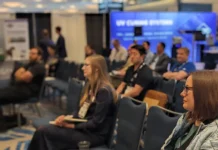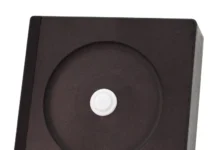IUVA YP Media Synthesis Group
Since the early stages of the COVID-19 pandemic, ultraviolet (UV) technologies have been used to mitigate viral infections through disinfection of personal protective equipment, surfaces and air. Recent media attention has shifted towards using the technology to safely reopen schools and businesses while following regulation for maximum allowable daily UV-C exposure dose of 23 mJ/cm2 at 220 nm and 6 mJ/cm2 at 254 nm. These articles highlight the potential use of (i) UV-C lights in non-human occupied areas and surfaces and (ii) far-UV-C light for in-situ use with human activity.1
New products developed in the UV-C range follow a trend of shielding humans from ultraviolet exposure to assure consumer safety. Technologies, such as UV AIR, claim to disinfect 100 m3 of air by passing it through an enclosed UV lamp in personal and commercial spaces.2 Various enclosed cabinets, such as LiteSheet, claim >5 log reduction of SARS-CoV-2 virus on personal equipment and3 airport technologies, such as UV-C tray disinfection by Vanderlande, claim to inactivate 99.9% of bacteria between each use.4 Additionally, Samsung released fan-designed concepts of handheld devices that use UV-C LEDs and dry air to disinfect facemasks while measuring particulate matter present on the fabric.5
According to these articles, when UV technologies are appropriately used, they effectively inactivate both SARS-CoV-2 virus and other microbes and show high potential for widespread implementation. For example, various school districts – including the Waterloo Catholic District School Board – are choosing to implement UV Air purifiers around the classroom,6 and Boeing has partnered with Healthe to produce and use UV wands to disinfect aircrafts in between use.7
Alongside UV-C technologies, inactivation by far-UV-C lamps continue to gain media attention. According to Columbia University Irving Medical Center, UV 222 nm cannot penetrate the dead-cell layer at the surface of human skin, so although it kills viruses in the air, it will theoretically not cause damage to humans. The article highlights that inexpensive far-UV-C lamps are being developed for use in conventional lighting fixtures for implementation in public spaces in-situ to occupation.8 Karl Linden addresses far-UV-C radiation for humans in the article “Ultraviolet Light Can Make Indoor Spaces Safer During the Pandemic – If It is Used the Right Way.” The article mentions that although mouse models do confirm that far-UV-C radiation is non-damaging to mouse models, not enough is known about exposure to the eyes or injured skin. More testing must be done to assure safety for human exposure.9
References
[1] https://www.icnirp.org/cms/upload/publications/ICNIRPUV2004.pdf
[2] https://cleanlightmedical.com/uv-air/
[3] https://www.litesheet.com/uv-c-sanitation-cabinet
[4] https://www.vanderlande.com/airports/innovative-systems/security-screening/uv-c-tray-disinfection/




